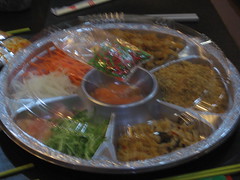About Me
Tuesday, February 12, 2008
Yusheng
Yusheng , yee sang or yuu sahng (simplified Chinese: 鱼生; pinyin: yúshēng) is a Chinese-style raw fish salad. It usually consists of strips of raw fish (most commonly salmon), mixed with shredded vegetables and a variety of sauces and condiments, among other ingredients. Yusheng literally means "raw fish" but since "fish (鱼)" is commonly conflated with its homophone "abundance (余)", Yúshēng (鱼生) is interpreted as a homophone for Yúshēng (余升) meaning an increase in abundance. Therefore, yusheng is considered a symbol of abundance, prosperity and vigor.
History
Fishermen along the coast of Guangzhou traditionally celebrated Renri, the seventh day of the Chinese New Year, by feasting on their catches.[1] This practice may have started in Chaozhou and Shantou as far back as the Southern Song Dynasty.[citation needed] In Malaya's colonial past, migrants imported this tradition; porridge stalls sold a raw fish dish which is believed to have originated in Jiangmen, Guangdong province that consisted of fish, turnip and carrot strips, which was served with condiments of oil, vinegar and sugar that were mixed in by customers. The modern yusheng dish originated in Malaya in what is modern Singapore during Chinese New Year in 1964 in Lai Wah Restaurant and was invented by master chefs Than Mui Kai (Tham Yu Kai, co-head chef of Lai Wah restaurant). [2] [3] [4] [5] [6] [7] [8] [9] [10] Together with Lau Yoke Pui (co-head chef of Lai Wah Restaurant), Hooi Kok Wai (founder of Dragon-Phoenix Restaurant) and Sin Leong, Than Mui Kai was named as one of the Four Heavenly Culinary Kings of Singapore some 40 years ago for their Cantonese culinary prowess and ingenuity. The taste of the original raw fish dish was standardized with a special sauce using plum sauce, rice vinegar, kumquat paste and sesame oil, and the fish was served with carrots, chilli, turnips, limes, jellyfish, red pickled ginger, sun-dried oranges and other ingredients, turning this simple dish into an exquisite salad with 27 ingredients.[11][12] The original dish used raw mackerel, although in deference to the popular wishes of customers, salmon was later offered as an alternative. Initially intended as a promotional gimmick to drum up business to Hooi, Lau, Sin and Than's respective restaurants, this dish rapidly became popular all over Singapore and has since spread to Malaysia and Hong Kong as well.
Since then, yusheng has become a staple Chinese New Year dish in Singapore as well as in Chinese communities in Malaysia and is typically available only during this festive season. It is also popular in Hong Kong.
Today, this dish is served as an appetizer to raise 'good luck' for the new year and is usually eaten on Renri, the seventh day of the Chinese New Year. In a celebration known as "lo hei"(Cantonese 撈起 or 捞起), families and friends to gather around the table and, on cue, proceeding to toss the shredded ingredients into the air with chopsticks while saying 吉祥话 (Jíxiáng Huà, auspicious wishes) out loud to mark the start of a prosperous new year.
Typical ingredients include: fresh salmon, daikon (white radish), carrot, red pepper (capsicum), ginger, daun limau nipis (leaves from lime tree), Chinese parsley, chopped peanuts, toasted sesame seeds, Chinese shrimp crackers (or fried dried shrimp), five spice powder. The dressing is made primarily from plum sauce
Subscribe to:
Post Comments (Atom)



No comments:
Post a Comment